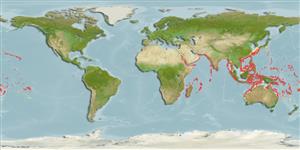>
Eupercaria/misc (Various families in series Eupercaria) >
Lutjanidae (Snappers) > Etelinae
Etymology: Pristipomoides: Greek, pristis = saw + Greek, poma, -atos = cover, operculum + Greek, oides = similar to (Ref. 45335).
More on author: Bleeker.
Environment: milieu / climate zone / depth range / distribution range
Ecologia
marinhas bentopelágico; intervalo de profundidade 100 - 360 m (Ref. 9821). Deep-water; 35°N - 32°S, 30°E - 143°W (Ref. 55)
Indo-Pacific: East Africa to Hawaii, and northward to southern Japan. A single specimen, apparently of this species, obtained from Vema Seamount in the southeast Atlantic.
Tamanho / Peso / Idade
Maturity: Lm ? range ? - ? cm
Max length : 79.0 cm TL macho/indeterminado; (Ref. 40637); common length : 40.0 cm TL macho/indeterminado; (Ref. 30573); peso máx. publicado: 8.4 kg (Ref. 40637)
Espinhos dorsais (total): 10; Raios dorsais (total): 11; Espinhos anais 3; Raios anais : 8. Interorbital space flat. Lower jaw slightly protruding. Bases of dorsal and anal fins without scales, their last soft rays extended into short filaments. Pectoral fins long, reaching level of anus. Scale rows on back parallel to lateral line. Body is silvery with lavender hue; the top of the head with dark spots; margin of the dorsal fin orange; the caudal fin purplish with the inner margin of the fork pale.
Adults are found over rocky bottoms (Ref. 30573); off Guam, caught most abundantly from about 180 to 270 m (Ref. 9821). They feed mainly on fishes, shrimps, crabs, polychaetes, cephalopods and urochordates. Marketed mostly fresh. Caught mainly with bottom longlines and deep handlines.
Ciclo de vida ou comportamento de acasalamento
Maturidade | Reprodução | Desova | Ovos | Fecundidade | Larvas
Allen, G.R., 1985. FAO Species Catalogue. Vol. 6. Snappers of the world. An annotated and illustrated catalogue of lutjanid species known to date. FAO Fish. Synop. 125(6):208 p. Rome: FAO. (Ref. 55)
Status na Lista Vermelha da UICN (Ref. 130435)
Ameaça para os humanos
Harmless
Uso pelos humanos
Pescarias: espécies comerciais; peixe esportivo: sim
Mais informação
Nomes comunsSinônimosMetabolismoPredadoresEcotoxicologiaReproduçãoMaturidadeDesovaAgregação de desovaFecundidadeOvosDesenvolvimento dos ovos
ReferênciasAquaculturaPerfil para aquaculturaEstirpesGenéticaElectrophoresesHereditariedadeDoençasProcessamentoNutrientsConversão de massa
Ferramentas
Relatórios especiais
Baixar XML
Fontes da internet
Estimates based on models
Preferred temperature (Ref.
123201): 13.8 - 23.1, mean 18.2 °C (based on 265 cells).
Índice de diversidade filogenética (Ref.
82804): PD
50 = 0.5005 [Uniqueness, from 0.5 = low to 2.0 = high].
Bayesian length-weight: a=0.01445 (0.00833 - 0.02507), b=2.99 (2.84 - 3.14), in cm total length, based on LWR estimates for this species & Genus-body shape (Ref.
93245).
Nível Trófico (Ref.
69278): 3.7 ±0.2 se; based on diet studies.
Generation time: 3.1 ( na - na) years. Estimated as median ln(3)/K based on 1
growth studies.
Resiliência (Ref.
120179): médio(a), tempo mínimo de duplicação da população 1,4 - 4,4 anos (K=0.3).
Fishing Vulnerability (Ref.
59153): Moderate vulnerability (36 of 100).
Nutrients (Ref.
124155): Calcium = 14.8 [6.6, 37.9] mg/100g; Iron = 0.371 [0.160, 0.799] mg/100g; Protein = 17.2 [15.3, 19.0] %; Omega3 = 0.342 [0.151, 0.671] g/100g; Selenium = 20 [9, 46] μg/100g; VitaminA = 15.9 [3.5, 83.8] μg/100g; Zinc = 0.34 [0.22, 0.53] mg/100g (wet weight);
